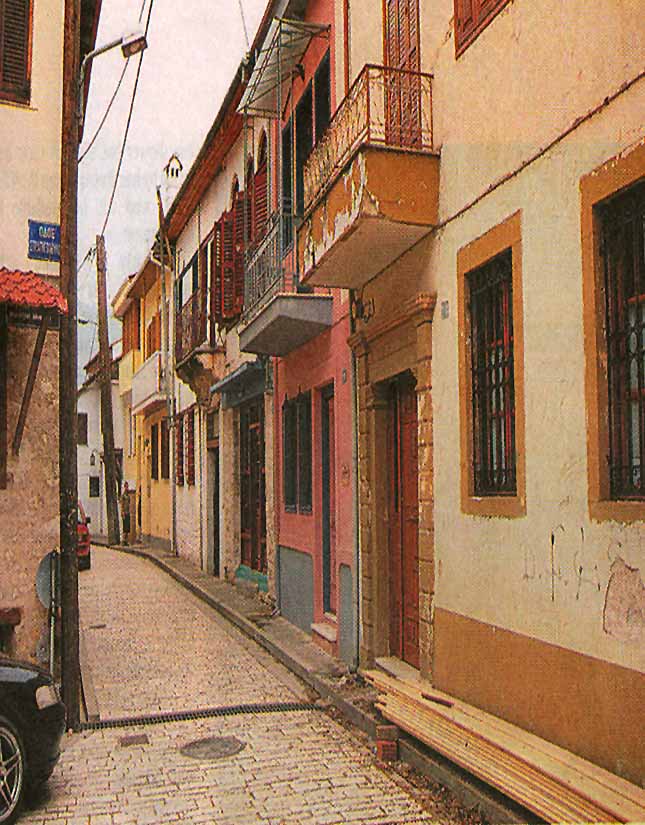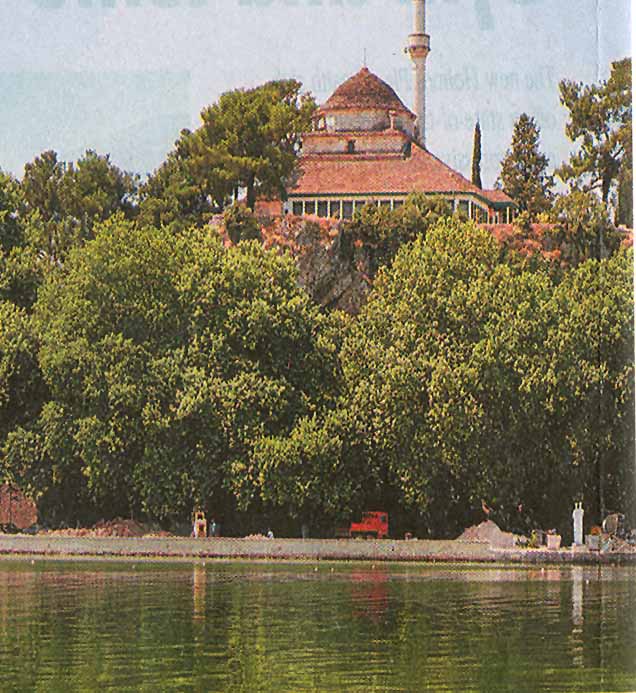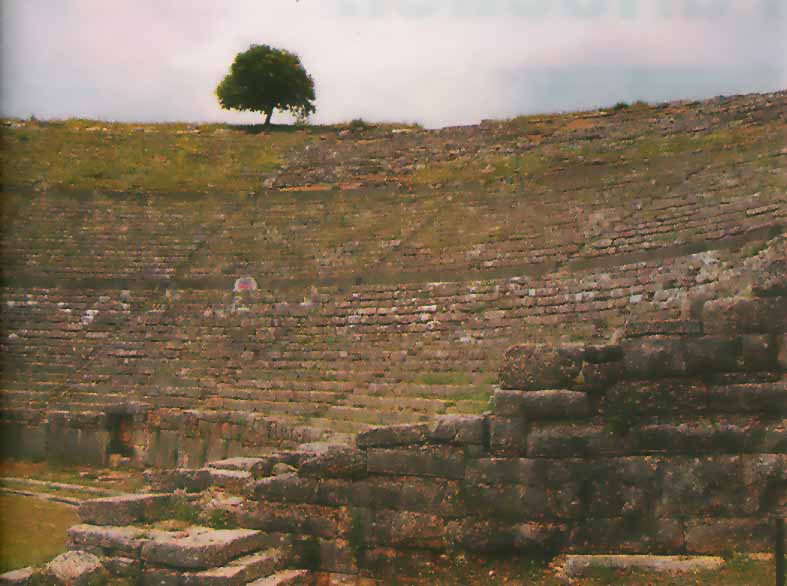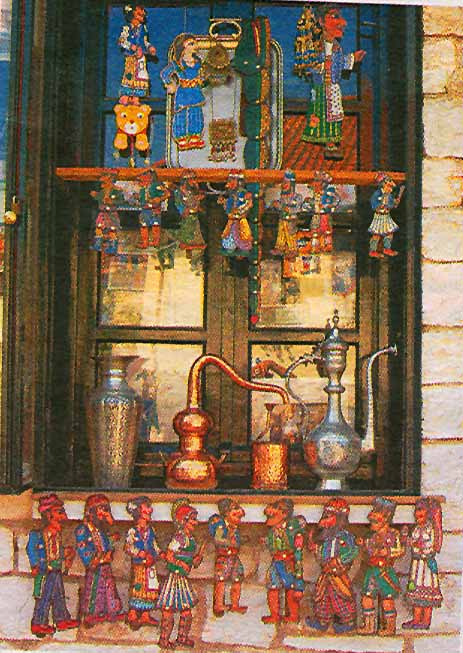 |
||
|
Yannina, City on the Lake
|
||
|
Beautifully situated, the capital of Epiros maintains imposing relics of its glory time when it was a centre of culture and trade rivalled only by Salonica
By Diana Farr Louis |
 Rarely higher than two floors, houses in old Yiannina are painted mellow shades of peach, pink and blue |
|
|
If you think that Yannina was Turkish for almost five hundred years and that the male population wore fezzes until 1913, this Anatolian heritage is not surprising. Even so, when freedom came elsewhere in Greece, minarets were toppled as the symbol of the oppressor. Except for those in Thrace, which still supports a Muslim minority, I cannot remember seeing any others intact on the mainland. Strangely, too, for such a beautifully situated town, Yannina has no ancient predecessors. Medieval texts mention a community named after a monastery dedicated to St John (Ioannis{Yannis) the Baptist in the 9th and 10th century, but its history doesn't really begin until after 1204. The nefarious conquest of Constantinople engineered by the Doge of Venice sent refugees scurrying westward. Some of them ended their flight on the island in Lake Pamvotis; others did not rest until they reached Corfu. |
||
 Slate-domed mosques break through the city's foliage |
|
|
|
Outside the castle, the city is prey to the traffic snarls, anonymous apartment and office blocks, and exaggerated decibels that reign in most Greek metropolises. Step inside and the lanes are miraculously quiet, the houses rarely higher than two floors and painted mellow shades of peach, apricot, pink, blue and cream. Miraculously, they are neither cute nor kitsch. |
||
|
Besides houses, the castle encloses all sorts of more imposing relics of its glory time, when Yannina was a centre of culture and trade rivalled only Salonica. Most of these lie within two citadels, slightly elevated above the rest of the city and surrounded by their own fortifications. The larger of the two, Its Kaleh, still bears the stamp of Ali Pasha. |
 Built by Pyrrhos in the 3rd Century BC, the Dodoni theatre seats 17,000 spectators |
|
|
|
||
 Display of Karaghiozi figures and hookahs at a local shop |
|
|
|
As we wandered round the Kastro by day and by night we kept stumbling across vestiges of the Ottoman era. An enormous 50-windowed building turned out to have housed AIi Pasha's riding school. A weed-tufted dome belonged to an abandoned hammam. A simple stone facade with a star of David over the locked door was the only reminder of Yannina' s once substantial Jewish community. In March 1944, virtually all of the city's two thousand Greek-speaking Romaniote Jews, whose roots in Greece date back to Augustus if not Alexander the Great, were deported to Auschwitz. A mere fifty live in Yannina now.
In the Kastro's other citadel a mosque built in the 17th century by Asian Pasha is a tribute to Yannina's former multi-culti mix. As the Municipal Museum, it exhibits Greek costums,weapons and jewellery; Ottoman silks, brass objects and furniture; and Jewish documents, more costumes and synagogue screens. But the mosque itself is a work of art inside and out. A slate roof spreads like an apron under the dome and minaret and over white plaster walls broken up by almost continuous tall windows. Inside, delicate geometrical patterns in red, grey and black frame the high white dome and comers, producing an almost ethereal lightness. Together with the Imaret in Kavala, it is one of Greece's finest Islamic monuments. It was evening when we emerged outside the castle walls. Walking along them in the direction of the lake, we passed one silver shop after another: At first I lingered - what female can resist the lure of a new pair of earrings or a bracelet? Some trinkets, though made yesterday, were almost as enticing as the pieces in the museum. My spouse's glazed look of infinite resignation tore me loose. As we got closer to the lake, the noise engulfed us. Coming from a row of trendy cafes, the babble of Yannina's jeunesse dorie combined with the music of a dozen different sound systems sent my hands to my' ears. Each establishment looked, so ineffably chic - white awnings, plump sofas, elegant wooden tables - they could have illustrated Architectural Digest, but I knew that breakfast would be the only time I could have enjoyed sitting there. We pushed through them towards the quieter restaurant zone; where each taverna window had five or six spits whirling with meaty temptations. In Yannina, the souk mentality prevails. Professions stick together here, as they do from Cairo to Marrakesh. And craving Eastern food, we sat down at Stin Ithaki Contrary to its name, its menu is Turkish not Ionian. Protected by the awning from a gentle drizzle, we watched the lights switch on round the lake, twinkling constellations that revealed the existence of other gathering spots under the thick trees between the castle walls and the calm lake. Rowers in single and double sculls glided over the surface like Jurassic water beetles until the drizzle became a downpour. The next day, dry and sunny, we did what every tourist does in Yannina: we hopped on a boat to the reedy shores of the island, generically referred to as Nisi. Everyone comes here for the thrill of seeing the monastic cell where Ali Pasha met his comeuppance, so we obediently followed the signs. But a few years ago a tree fell on Agios Panteleimon monastery, the floor with the bullet holes has been replaced, and the little museum does not do justice to the legend. We should have saved our energy for the real prize - the two main monasteries (of the seven) founded by refugee Byzantine families in the 13th century. Both the Philanthropinos and Stratigopoulos (or Dilios) monasteries are dediglted to St Nicholas. Both are guarded by formidable old crones who will unlock the doors in exchange for a tip, while complaining about their lumbago and eyeing. you suspiciously as you examine the extraordinary frescoes that cover every square inch of the church walls. This can take quite a while as their artists depicted, the satanic tortures of the damned and martyred with the zeal of Hieronymos Bosch, and macabre images and imaginary beasties have a fascination the more usual NewTestament scenes cannot match. Sorely conscious of the guardians' restive glares, I did not stay as long as I'd have liked. I joined my husband in the cafe in the square, where he was the only non-local. We compared notes. He'd found out that while only 300 people live on the island, it boasts 580 registered voters. The same families have owned its 110 slate-roofed houses for generations and no one would ever dare sell to an outsider. They live off tourism and yet apart from the handful of fish-tank tavernas and silver shops, it is remarkably uncommercial. Sure, souvenirs are thrust at you when you file up the street from the dock. But they consist of samples of delectable sweets: flower-shaped crushed almond confections, honey-soaked pastries, gooey Turkish delight. You could make a meal from these handouts, the only hint of Anatolia on Nisi. I confess we did not venture deep into modern Yannina. Tile archaeological museum, considered a masterpiece of contemporary architecture designed by Aris Konstantinidis, was shut for repairs. Besides, our waiter at Stin Ithaki had said, "Yannina is continually in the throes of a radical facelift. Stay away for a couple of years and even if you grew up here, you won't recognise a thing". But some things endure: the castle, the lake and the ghost of Ali Pasha hovering around them. We got into the car to do the next thing that most tourists do after they've seen Yannina - head for the mountains. Dodoni (22km south of Yannina) The Oracle at Dodoni, second only to Delphi in importance, was the oldest in Greece. Here Zeus married the Great Goddess in one of her guises (Dione, simply means wife of Zeus) and set up house in a giant oak. The Oracle spoke through a curious combination of rustlin leaves and the vibrations set off when the priests struck. one of a series of bronze cauldrons that ringed the sacred tree. (Might they have sounded like 'Om'?) So great was the Oracle's reputation that when the Christians sacked it, they also uprooted all the oak trees. Pyrrhos built the famous theatre in the 3rd century BC to seat 17,000 spectators (about 3,000 more than Epidaurus). A restoration programme means that the drama festival has been put on hold. How to Get There Flying to Yannina by Aegean or Olympic is the quickest option if all you want is a weekend change of scene. There's no need for a car in town and you can catch a bus to Dodoni Where to Stay (Area Code 26510) "The Hotel Kastro (22866), inside the castle walls, next to Its Kaleh and the Byzantine Museum, has seven rooms in. a beautifully restored 19th-century home decorated in Yianniotiko Neoclassic style. In town, the Tourist (26443) and the Palladion (25856) are relatively quiet and convenient Where to Eat The lakefront offers a rarity: delicious food in a splendid location at reasonable prices. Apart from the rotisseries at the start of taverna row, Stin Ithaki specialises in fabulous mezedes from lAnatolia, while Limni is place to go for fish and seafood. Last year Stin Ithaki hired a chef from Istanbul to teach its staff how to prepare the exotic delicacies for which the city is famous. The only danger is that the menu's so tempting your eyes may be bigger than your stomachs. Yannina's island tavernas are renowned for their trout, crayfish, eels and frogs' legs. They now come from farms, not the great ,green, grassy waters of the lake. |
||
HCS readers can view other excellent articles by the Athens News writers and staff in many sections of our extensive, permanent archives, especially our News & Issues, Travel in Greece, Business, and Food, Recipes & Garden sections at the URL http://www.helleniccomserve.com./contents.html
All articles of Athens News appearing on HCS have been reprinted with permission. |
||
|
||
|
|
||
|
2000 © Hellenic Communication Service, L.L.C. All Rights Reserved.
http://www.HellenicComServe.com |
||

